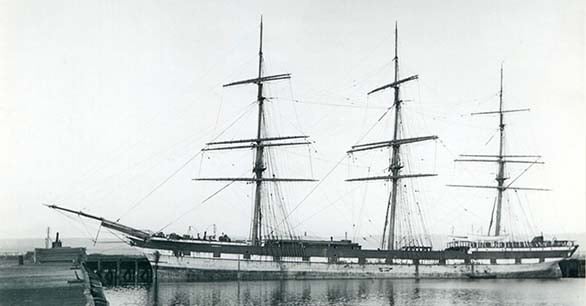Harbinger

The build
Launched in 1876, Harbinger had been built at Greenock for the Orient Line's Australia services. The vessel could accommodate up to 230 passengers and carried general cargo outbound and mainly wool on the return journey.
Of 1,585grt and 253.5ft loa the iron-hulled Harbinger had three masts and was described by crew as being easy to handle, capable of covering around 300 miles a day and chalking up a top speed of 16 knots.
Ocean Training Scheme
The Ocean Training Scheme was created by Lord Thomas Brassey, a British former Liberal MP who had served as Civil Lord of the Admiralty and Parliamentary Secretary to the Admiralty.
Alarmed at the damage caused by 'bitter international competition', Lord Brassey had been lobbying for a UK state-supported seafarer training scheme to be funded by light dues paid by visiting foreign ships. He was also worried that the poor standard of many apprenticeships – with many aspiring officers used 'merely as drudges to do all the dirty work onboard' – was stoking up a shortage of skilled British seafarers.
To address this situation, the peer joined with London-based shipping company Devitt & Moore in 1890 to provide 'a professional education for the sons of gentlemen' which would enable them to become officers in the mercantile marine.
Parents were invited to pay up to £250 for their sons to serve as a midshipman for four or five return journeys to Australia, during which they would be trained in seamanship, navigation 'and the other duties of an officer at sea.'
Harbinger was one of two ships that was modified to operate the Ocean Training Scheme. The vessel was fitted with accommodation and teaching space for up to 30 cadets, who were expected to play a full part in the operation of the vessels while also attending classes and taking exams on every voyage.
The ships carried a special officer responsible for the welfare and education of the cadets. Arithmetic, algebra, geometry, navigation and nautical astronomy were taught in the classroom, whilst instruction in seamanship was given during the midshipmen's watches on deck.
Ownership
Harbinger and sistership Hesperus were bought for Lord Brassey's training scheme early in 1890.
However, the economics of Australian trades coupled with the growing use of steamships meant both vessels were increasingly judged to be inappropriate, and Harbinger was sold in 1898, followed by Hesperus in 1899.
Harbinger operated in the Baltic for a Finnish shipowner until being sold for scrapping in Belgium in August 1910, while Hesperus was broken up in Italy in 1923.
Legacy
The Ocean Training Scheme ran with larger ships until 1918 after Devitt & Moore founded the nautical college at Pangbourne in Berkshire by using the proceeds from the sale of one of the training ships, Port Jackson.
Harbinger Fact File
How big was Harbinger?
Harbinger had a grt of 1,585 and a loa of 253.5ft
When was Harbinger launched?
Harbinger was launched in 1876
When did the Ocean Training Scheme begin?
The scheme began in early 1890 and ran up until 1918 when the Nautical College at Pangbourne was founded
When did Harbinger leave service?
Harbinger was sold for scrapping in 1910
Contribute
Are you knowledgeable about this vessel?
Submit your contribution to this article to our editorial team.
Write to usView more ships of the past
HMS Beagle
Launched 200 years ago, HMS Beagle has been described as one of the most important ships in history – thanks to the observations on evolution and natural selection that its famous passenger Charles Darwin made during a five-year voyage around the world between 1831 and 1836.
Common.ReadMoreHMS Beagle
Malakand
Launched in November 1918, the Malakand was a sistership to three other vessels and was fitted to train cadets until the shipping slump of the 1920s. With an uneventful early career, the Malakand later became the victim of Liverpool's May Blitz in 1941.
Common.ReadMoreMalakand
Manxman
Over the past century two vessels serving with the Isle of Man Steam Packet Company (IOMSPCo) have borne the name Manxman, with the company's newest ferry – due to enter service in 2023 – set to be the third.
Common.ReadMore